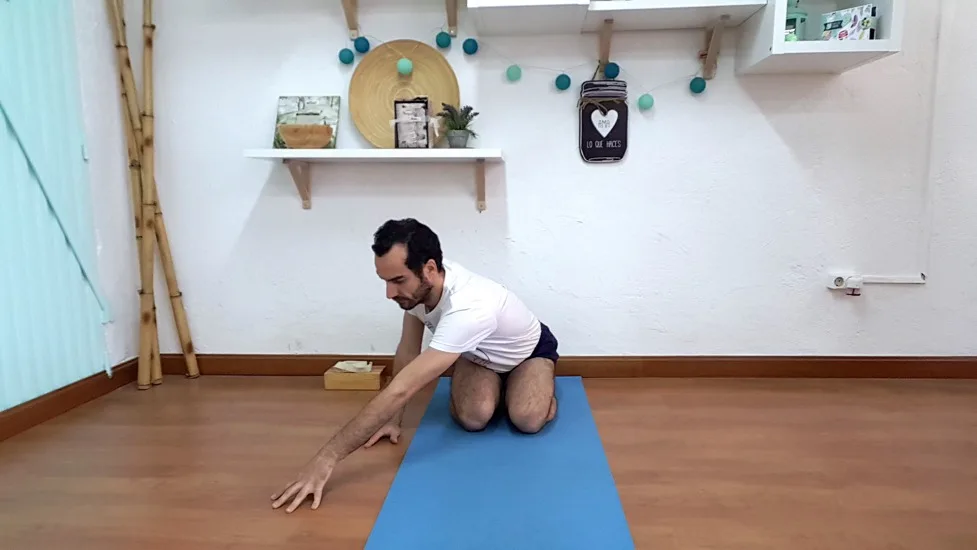Adho Mukha Parshva Vajrasana, also known as Downward-Facing Thunderbolt Twist Pose, is a powerful pose that can help to build strength and flexibility, cultivate a sense of inner calm and focus, and deepen your connection to yourself and your practice.
Information
| Known as: | Adho Mukha Parshva Vajrasana, Downward-Facing Thunderbolt Twist Pose |
| Sanskrit name: | अधो मुख पर्श्व वज्रासन |
| IAST: | adho mukha pārśva vajrāsana |
| Pronunciation: | uh-doh moo-kuh parsh-vuh vuh-jrah-suh-nuh |
| Level: | Intermediate |
| Type: | Seated pose |
| Focus: | Arms, shoulders, core |
| Total time: | 30 seconds to 1 minute on each side |
| Drishti: | Forward (directed toward the hand) |
| Chakra: | Manipura (solar plexus), Anahata (heart) chakra |
| Indications: | Hips, thighs, and hamstrings, arms, shoulders, abdomen, digestion, detoxification, balance, coordination, relaxation, stress, anxiety |
| Counterposes: | Uttanasana (Standing Forward Bend), Balasana (Child’s Pose), Bharadvajasana (Bharadvaja’s Twist), Bhujangasana (Cobra Pose) |
| Preparatory poses: | Adho Mukha Svanasana (Downward-Facing Dog Pose), Marjaryasana-Bitilasana (Cat-Cow Pose), Gomukhasana (Cow Face Pose), Supta Padangusthasana (Reclining Hand-to-Big-Toe Pose) |
| Follow-up poses: | Uttanasana (Standing Forward Bend), Ardha Matsyendrasana (Half Lord of the Fishes Pose), Anjaneyasana (Low Lunge Pose), Adho Mukha Svanasana (Downward-Facing Dog Pose) |
| Contraindications: | Wrist injuries, neck injury or sensitivity, high blood pressure or low blood pressure, pregnancy |
Meaning
Adho Mukha Parshva Vajrasana is a Sanskrit term that can be made five words — Adho + Mukha + Parshva + Vajra + Asana:
- “Adho” = “downward”
- “Mukha” = “face”
- “Parshva” = “side”
- “Vajra” = “thunderbolt”
- “Asana” = “pose” or “posture”
Therefore, Adho Mukha Parshva Vajrasana can be translated to mean “the posture of the downward-facing thunderbolt twist,” which reflects the strength and power of the pose and its combination of a forward fold and twist.
Benefits of Downward-Facing Thunderbolt Twist Pose
Adho Mukha Parshva Vajrasana is a powerful pose that can help to improve both physical and mental well-being. practicing this pose regularly can build strength and flexibility, cultivate a sense of inner calm and focus.
However, the physical and mental benefits of this yoga pose are listed below:
Physical Benefits:
- Strengthens the arms, shoulders, and core muscles.
- Stretches the hips, thighs, and hamstrings.
- Improves spinal flexibility and mobility.
- Stimulates digestion and aids in detoxification by compressing the abdomen.
- Relieves tension in the neck, shoulders, and upper back.
- Can help to improve balance and coordination.
Mental benefits:
- Calms the mind and promotes relaxation.
- Can help to reduce stress and anxiety.
- Increases body awareness and mindfulness.
- Can help to improve focus and concentration.
- Promotes a sense of inner stability and grounding.
Step-by-step instructions to Adho Mukha Parshva Vajrasana
- Begin in Adho Mukha Vajrasana (Downward-Facing Diamond Pose) with your knees and shins on the ground and your hips resting on your heels.
- Inhale and lift your right arm up toward the ceiling, twisting your torso to the left.
- Exhale and reach your right arm across your body, placing your right hand on the ground outside your left knee.
- Press your left hand into the ground behind you and inhale, lengthening your spine.
- Exhale and deepen the twist, turning your gaze over your left shoulder.
- Stay in the pose for 30 seconds to 1 minute, breathing deeply.
- To come out of the pose, inhale and lift your right arm up toward the ceiling, returning to Adho Mukha Vajrasana.
- Repeat the pose on the other side by lifting your left arm up and twisting your torso to the right.
Tips
- Keep your spine long and your shoulders relaxed throughout the pose.
- Make sure both hips remain on the heels and the knees remain close together.
- Take deep, steady breaths in and out through the nose.
- If you have any knee or hip injuries or discomfort, you can modify the pose by placing a folded blanket or cushion between your hips and heels for added support.
Precautions and contraindications
Iit’s essential to practice this yoga pose mindfully and with awareness of your body’s limitations. Approach this pose with caution and take precautions if you have any pre-existing conditions or injuries. Here are some precautions and contraindications to keep in mind when practicing this yoga pose:
- Wrist injuries: If you have a wrist injury, it’s important to be cautious when placing weight on your hands in this pose. You can modify the pose by placing your forearms on the ground instead of your hands, or by using props like blocks or blankets to support your hands and wrists.
- Neck injuries: If you have a neck injury or sensitivity, it’s important to be cautious when turning your head in this pose. You can modify the pose by keeping your gaze downward or straight ahead, or by using a block or blanket to support your head and neck.
- High or low blood pressure: If you have high blood pressure or low blood pressure, it’s important to be cautious when practicing inversions like this pose. You can modify the pose by practicing a gentler twist or skipping the pose altogether.
- Pregnancy: If you’re pregnant, it’s important to avoid deep twists and inversions in your practice. You can modify the pose by practicing a gentler twist or skipping the pose altogether.















